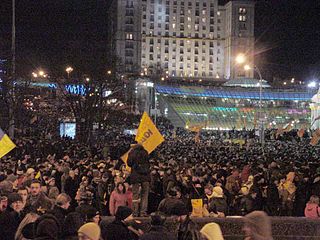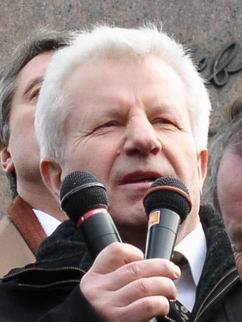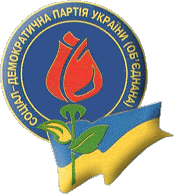
The Socialist Party of Ukraine was a social democratic and democratic socialist political party in Ukraine. It was one of the oldest parties in Ukraine and was created by former members of the Soviet-era Communist Party of Ukraine in late 1991, when the Communist Party was banned. The party was represented in the Verkhovna Rada, Ukraine's parliament, from 1994 to 2007 and was the third and fourth largest party during that period. From 2007 onwards the party's electoral results became increasingly marginal, failing to win any seats in subsequent elections despite historically strong support in the central regions of the country. Oleksandr Moroz had led the party for more than twenty years before his resignation in 2012.

The hryvnia has been the national currency of Ukraine since 2 September 1996. The hryvnia is divided into 100 kopiyok. It is named after a measure of weight used in Kievan Rus'.

Leonid Makarovych Kravchuk was a Ukrainian politician and the first president of Ukraine, serving from 5 December 1991 until 19 July 1994. In 1992, he signed the Lisbon Protocol, undertaking to give up Ukraine's nuclear arsenal. He was also the Chairman of the Verkhovna Rada and a People's Deputy of Ukraine serving in the Social Democratic Party of Ukraine (united) faction.

The karbovanets or karbovanet, also known as kupon or coupon, has been a distinct unit of currency in Ukraine during three separate periods of the 20th century. It is also a predecessor currency of today's Ukrainian hryvnia.

Below is the timeline of events that followed the runoff presidential election held in Ukraine on 21 November 2004 that sparked off the "Orange Revolution".

The Prime Minister of Ukraine is the head of government of Ukraine. The prime minister presides over the Cabinet of Ministers of Ukraine, which is the highest body of the executive branch of the Ukrainian government. The position replaced the Soviet post of chairman of the Council of Ministers of the Ukrainian SSR, which was established on March 25, 1946.

Ukraine without Kuchma was a mass protest campaign that took place in Ukraine in 2000–2001, demanding the resignation of President Leonid Kuchma, and preceding the Orange Revolution. Unlike the Orange Revolution, Ukraine without Kuchma was effectively extinguished by the government enforcement units, and followed by numerous arrests of the opposition and the Ukrainian-speaking participants. Seeking the criminal responsibility for those events was renewed with the election of Viktor Yanukovych as the President of Ukraine.

Oleksandr Oleksandrovych Moroz is a Ukrainian politician. He was the Chairman of the Verkhovna Rada twice, from 1994 to 1998 and again from 2006 to 2007. Moroz is one of the founders and the leader of the Socialist Party of Ukraine, formerly an influential political party in Ukraine. Moroz lost parliamentary representation when the Socialist Party failed to secure sufficient number of votes (2.86%) in the 2007 snap parliamentary election, falling 0.14% short of the 3% election threshold.

Vadym Petrovych Hetman was a Ukrainian statesman, politician, and banker. He is credited with the creation of the National Bank of Ukraine, Ukraine's central bank. He was assassinated in April 1998 in his home in Kyiv. According to the Prosecutor General of Ukraine, the crime was paid for by former Prime Minister of Ukraine Pavlo Lazarenko. He was posthumously conferred the title of Hero of Ukraine on 11 July 2005.

The National Bank of Ukraine or NBU is the central bank of Ukraine – the government body responsible for a unified state policy in the field of the country's monetary circulation, including the strengthening of the national currency unit, the hryvnia. The National Bank of Ukraine employs over 12,000 people, making it one of the leading banks. It regulates and supervises activities, functions and the legal status of government and commercial banks based on the principles of the Constitution of Ukraine and the law of Ukraine.

The Social Democratic Party of Ukraine (united) (Ukrainian: Соцiал-демократична партія України (об'єднана), romanized: Sotsial-demokratychna partiia Ukrainy (obiednana)), abbreviated as SDPU(o) (Ukrainian: СДПУ(о)) is a Ukrainian political party that was originally established as the Social Democratic Party of Ukraine. At the 1998 and 2002 parliamentary elections it won parliamentary seats, but has since then failed to win any seats. When in the Verkhovna Rada the party was influential, but since the Orange Revolution (of late 2004) it has been marginalized.

Eduard Yosypovych Hurvits is a Ukrainian politician who served as the 71st mayor of Odesa on two occasions; first from July 1994 to 26 May 1998, and then from 5 April 2005 to 6 November 2010. He also served as a People's Deputy of Ukraine on two occasions, from 27 March 1994 to 26 March 2006 and from 28 October 2012 to 26 October 2014.

Viktor Mykhailovych Pynzenyk is a Ukrainian politician, economist, and former Minister of Finance. He is the former leader of the Reforms and Order Party.

The President of Ukraine is the head of state of Ukraine. The president represents the nation in international relations, administers the foreign political activity of the state, conducts negotiations and concludes international treaties. The president is directly elected by the citizens of Ukraine for a five-year term of office, limited to two terms consecutively.
Russia's monetary reform of 1993 took place from 26 July to 7 August 1993.
The National Bank of Ukraine has issued four banknote series since 1996. All banknotes in denominations of ₴1, ₴2, ₴5, ₴10, ₴20, ₴50, ₴100, ₴200, ₴500 and ₴1,000 issued after 2003 are considered legal tender. All of them depict an important person in Ukraine's history on the obverse and a landmark place on the reverse. The lowest four denominations are no longer issued in banknotes and are intended to be gradually substituted by coins, though they remain common. There have been four commemorative banknote issues.

Coins of the Ukrainian hryvnia were first minted in 1992. Coins were first struck in 1992 for the new currency but were not introduced until September 1996. Initially, coins valued between 1 and 50 kopiyok were issued. In March 1997, 1 hryvnia coins were added; they are however rarely seen in circulation. The note of the same value is far more commonly used. Since 2004 several commemorative 1 hryvnia coins have been struck. New coins have been produced annually since then and they make up a valuable aspect of the Ukrainian currency system. Today, circulating coins exist in denominations of 1 kopiyka, 2, 5, 10, 25 and 50 kopiyok, ₴1, ₴2, ₴5 and ₴10. Also minted are bullion and commemorative coins. All of these are produced by the National Bank of Ukraine.
The Ukrainian hryvnia has been the national currency of Ukraine since 1996. It was briefly used in the Ukrainian People's Republic before the karbovanets was adopted as a national currency. The hryvnia is named after the grivna, which was used in Kievan Rus' and other states.

The Makhnovist ruble was a banknote issued by the Revolutionary Insurgent Army of Ukraine, during the Ukrainian War of Independence, in the territory of the Makhnovshchina.




















